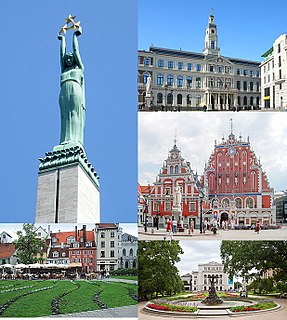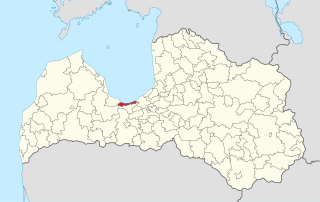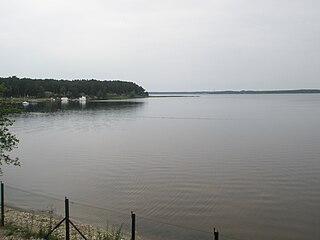
Riga is the capital of Latvia and is home to 632,614 inhabitants (2019), which is a third of Latvia's population. Being significantly larger than other cities of Latvia, Riga is the country's primate city. It is also the largest city in the three Baltic states and is home to one tenth of the three Baltic states' combined population. The city lies on the Gulf of Riga at the mouth of the Daugava river where it meets the Baltic Sea. Riga's territory covers 307.17 km2 (118.60 sq mi) and lies 1–10 m above sea level, on a flat and sandy plain.

Jūrmala is a city in Latvia, about 25 kilometres west of Riga. Jūrmala is a resort town stretching 32 km and sandwiched between the Gulf of Riga and the Lielupe River. It has a 33 km stretch of white-sand beach, and a population of 56,646, making it the fifth largest city in Latvia.

Rēzekne is a city in the Rēzekne River valley in Latgale region of eastern Latvia. It is called The Heart of Latgale. Built on seven hills, Rēzekne is situated 242 kilometres east of Riga, and 63 kilometres west of the Latvian-Russian border, at the intersection of the Moscow – Ventspils and Warsaw – Saint Petersburg Railways. It has a population of 31,216 (2016) making it the 7th largest city in Latvia.

Salaspils is a town in Latvia, the administrative centre of Salaspils Municipality. The town is situated on the northern bank of the Daugava river, 18 kilometers to the south-east of the city of Riga.

Riga International Airport is the international airport of Riga, the capital of Latvia, and the largest airport in the Baltic states with direct flights to 76 destinations as of November 2019. It serves as a hub for airBaltic, SmartLynx Airlines, RAF-Avia and as one of the base airports for Wizz Air. The Latvian national carrier airBaltic is the biggest in the airport, followed by Ryanair. The airport is located in the Mārupe Municipality west of Riga, approx. 10 km from its city centre.

Jugla is a neighbourhood of Riga, the capital of Latvia. It is located west of the Lake Jugla and southeast of the Lake Ķīšezers. Jugla is bordered by Čiekurkalns, Mežciems and Teika to the west, Dreiliņi to the southwest, Brekši to the southeast and Bukulti to the east.

Mežciems is a neighbourhood of Riga, Latvia. It is located in the eastern part of the city. The name is literally translated from Latvian as forest village. Mežciems is encircled by Šmerlis and Jugla forests. In the northern part of the neighbourhood there is Gaiļezers lake. In its beginnings Mežciems was part of Dreiliņi county characterized by single-family houses. The northern part of Mežciems was included in Riga in 1934. The southern part of Mežciems was built in the 1970s, when several apartment buildings were constructed, and included in city in 1974.

Ziepniekkalns is a neighborhood of Riga, Latvia. It is located in the Pārdaugava section of Riga close to the city's southern border. Ziepniekkalns is the latest out of all Riga's neighborhoods. It was built in the late 1980s and early 1990s and mostly consists of Soviet-built 10 story apartment buildings. However, there are still many older buildings in Ziepniekkalns constructed in the early 1960s. There is a major contrast between older 3 story buildings and newer 10 story ones. In the mid-1990s, route 19 trolleybus was extended to the heart of new Ziepniekkalns and now terminates at the IKI supermarket. The bus route 40 runs through the city center to Jugla.

Latvian Railways is the main state-owned railway company in Latvia with more than 12,400 employees. It owns 1,933.8 kilometres (1,201.6 mi) of 1,520 mmRussian gauge railway lines and 33.4 kilometres (20.8 mi) of 750 mm narrow gauge railway lines in Latvia. In 2019, annual passenger numbers were reported to be 18 million.

The Ethnographic Open-Air Museum of Latvia is an open-air museum located just outside Riga, the capital of Latvia, on the lightly wooded shores of Jugla Lake.

The Latvian Museum of National History, is a national history museum in Riga, Latvia.

Mazā Jugla is a river of Latvia. It flows for 119 kilometres through the municipalities of Ogre, Salaspils, Ikšķile and Stopiņi. The source of the river is located in Taurupe parish, Ogre Municipality 130 m above sea level, whereas the mouth is 0.1 m asl.
Berģi is a neighbourhood of Riga, the capital of Latvia.

The Riga–Lugaži Railway is a 166 kilometres (103 mi) long, 1,524 mm gauge railway in Latvia. It was built in the late 19th century to connect the cities of Riga and Saint Petersburg via Valga and Pskov. The railway was opened in 1889.

Ķīšezers is a lake in Riga, Latvia, with primary inflow of the Jugla River. The lake is 1,730 ha large, it has 2.4 metres of average depth and reaches 4.2 metres (14 ft) at the deepest point.

The Battle of Jugla was a defensive battle of the Russian Republic's 12th Army of the First World War from 1 to 3 September 1917. It was part of the German offensive called the Battle of Riga or Schlacht um Riga. The main objective for the Russian 12th Army was to prevent the German 8th Army from forcing the Daugava river and besieging Russian troops in Riga.

Edgars Vinters was a Latvian painter.
















